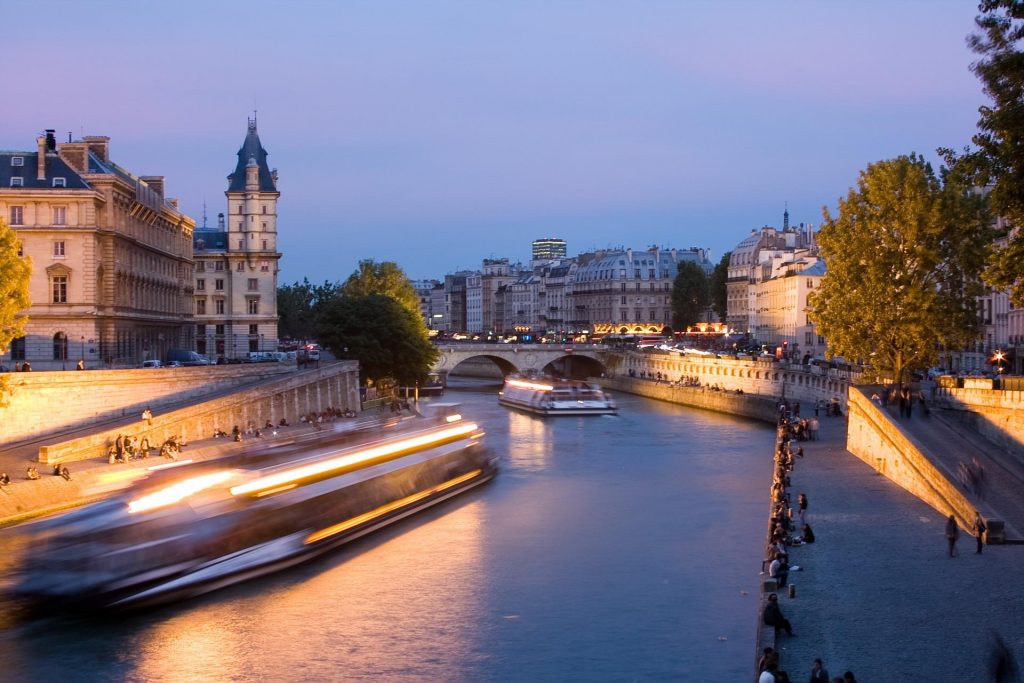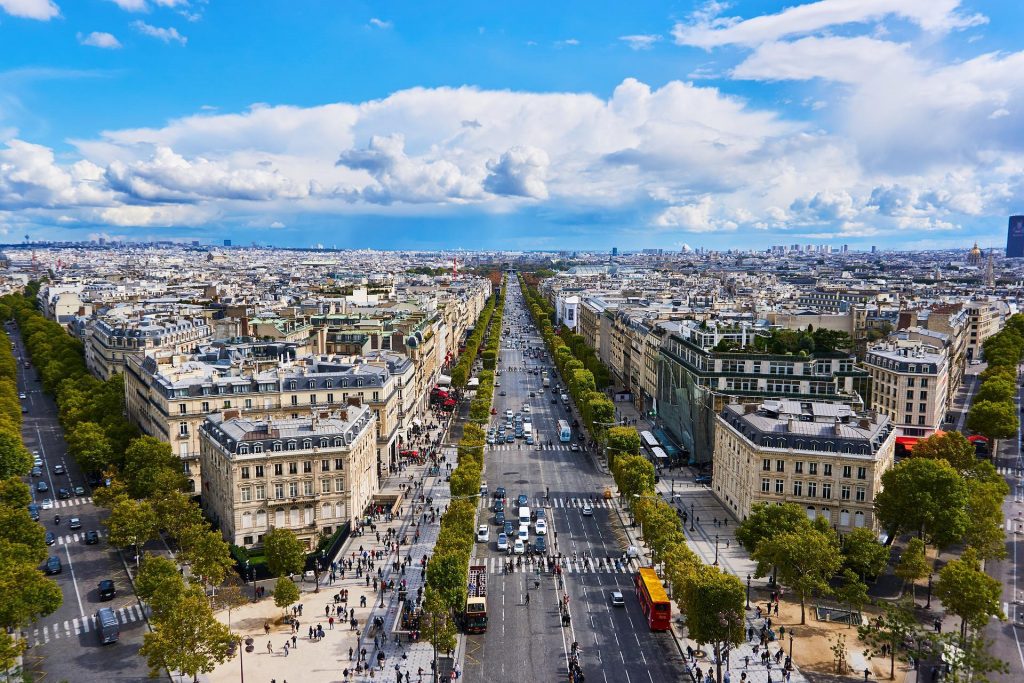Descubra 10 curiosidades pouco faladas sobre Paris

Nesse post apresentaremos um Top 10 com diversas curiosidades sobre a Cidade Luz, como é conhecida a grande Paris, capital da França. Apesar de não estar mais no primeiro lugar, a cidade ainda está entre as 10 cidades mais visitadas da Europa e do mundo, uma vez que se tornou uma cidade icônica, e um centro global de cultura, moda e arte.
Desde a Revolução Francesa, Paris desenvolveu seu próprio estilo de arquitetura, como o estilo Art Nouveau, e uma das consequências disso foi a sua repleta lista de pontos turísticos e lugares incríveis para se conhecer. A atração mais visitada de Paris é a Catedral de Notre Dame, com mais de 12 milhões de visitantes todos os anos, sem contar com seus vários museus, sendo alguns deles o Museu do Louvre, o Centre Pompidou e o Musée d’Orsay.
A cidade foi fundada diversas vezes, e uma das evidências disso pode ser encontrada em seu nome, que deriva da palavra gaulesa “paris”, que significa “a altura”. No entanto, a cidade foi originalmente chamada de Lutécia e tornou-se a capital da Gália em 27 aC, quando ficou conhecida como Civitas Parisiorum (Cidade dos Parisii).
1. História da Cidade
A história de Paris começa com a sua ocupação pela tribo celta dos Parísios, que se estabeleceram em uma ilha do Sena (Île de la Cité) devido à sua localização estratégica. Este primeiro povoado de pescadores e marinheiros caiu sob o poder dos romanos por volta do ano 52 a.C, e a ser chamada de Lutécia.
A cidade passou a se chamar Paris apenas no século IV, e segundo contam, durante essa época a cidade resistiu à uma grande invasão de Átila por intervenção de Santa Genoveva, que passou a ser a padroeira de Paris. E não acabou por aí, pois no Século XIV Paris viveu ao menos três revoltas: a Rebelião dos Comerciantes de 1358, com Etienne Marcel à frente; a Revolta dos Maillotins de 1382, quando os cidadãos se rebelaram com o aumento dos impostos; e a de 1413 de Caboche, quando um comerciante liderou uma multidão que acabou tomando a Bastilha.
2. Cultura

Paris tem uma rica herança cultural, tendo sido o lar de inúmeros movimentos artísticos como o Impressionismo e Art Nouveau. Os amantes da arquitetura encontrarão um pedaço de Paris em cada esquina, pois a cidade abriga alguns dos monumentos mais emblemáticos do mundo, como a Torre Eiffel ou a Catedral de Notre-Dame.
Desde o século 18, Paris tem sido um importante centro internacional de alta cultura, e foi a casa de alguns dos artistas mais famosos do mundo, como Renoir, Monet, e diversas outras personalidades conhecidas que deixaram sua marca nesta cidade. Paris é muito conhecida por sua atmosfera romântica e charme único, mas a cidade desempenhou um papel vital na formação da sociedade moderna, além de influenciar muitas outras culturas.
3. Segunda Guerra Mundial
Em 1940, Paris foi ocupada pelos alemães, e a população teve que passar por muitas dificuldades durante este período, uma vez que o exército alemão aterrorizaria a cidade com toques de recolher, proibindo reuniões e manifestações públicas, incursões em busca de judeus e saqueando quaisquer casas com suspeita de atividade da Resistência. A população de Paris naquela época era de cerca de 2 milhões de pessoas, e foi considerada pelos historiadores como uma das maiores cidades da Europa da época.
Em 1941, aviões alemães lançaram mais de 3.000 bombas em Paris, matando cerca de 2.500 pessoas todas as semanas durante três meses seguidos. Paris foi o centro político, cultural e intelectual do país por quatro anos, e também foi uma das cidades mais bombardeadas da Europa durante a Segunda Guerra Mundial.
A França foi um dos países a usar uma bomba atômica durante a Segunda Guerra Mundial, e o programa de pesquisa nuclear de alto nível do país levaram o presidente francês Charles de Gaulle a ordenar que seu país desenvolvesse suas próprias armas nucleares em 1960, em vez de depender da OTAN para defender o Pacto de Varsóvia com a União Soviética aparecendo como um potencial agressor.
4. Atrações Turísticas

Paris é uma das cidades mais visitadas do mundo, e conta com diversas atrações turísticas para oferecer a seus turistas. Uma de suas atrações é a Torre Eiffel, construída para a Exposição Internacional de Paris em 1889 e originalmente planejada para ser temporária. Outra atração bem famosa da cidade é a Catedral de Notre Dame, que era originalmente uma catedral gótica católica romana, mas agora serve como uma igreja dedicada a Santa Maria e sede do Arcebispado de Paris.
O Museu do Louvre, também conhecido como Palácio do Louvre é outra atração bastante frequentada pelos visitantes, e abriga muitas obras de arte de diferentes períodos, como pinturas de Leonardo da Vinci e Rembrandt van Rijn.
5. Patrimônio Mundial
A cidade é declarada Patrimônio Mundial da UNESCO desde 1991, o que significa que a cidade tem valor e importância universal para a humanidade. A UNESCO a lista como um dos 28 locais mundiais que melhor representam os ideais de realização humana, a lista também inclui sítios naturais como o Grand Canyon no Arizona e o Parque Nacional de Yellowstone em Wyoming.
Além disso Paris é uma das cidades mais antigas da França, e existem estudiosos que acreditam que sua fundação antecede até mesmo a fundação de Roma, abrigando algumas das peças arquitetônicas e de arte mais importantes do mundo. No entanto, Paris teve uma história bastante tumultuada em vários pontos, sendo ocupada pelos romanos, vikings e prussianos, até que finalmente seu povo conseguiu obter sua independência.
6. Culinária

Todo mundo adora comida francesa e a conhece bem, mas você sabia que os próprios franceses não concordam muito sobre o que é “cozinha francesa”? Isso ocorre porque a culinária parisiense não é o mesmo que a culinária provinciana ou rural. Na verdade, muitos dos pratos que são considerados clássicos franceses são na verdade de outras regiões, como a Bretanha. Mas pode-se dizer que a culinária francesa se originou em Paris, pois foi onde as pessoas começaram a cozinhar com manteiga e creme.
Embora a comida parisiense tenha sido historicamente influenciada pelas cozinhas de outros países, principalmente as do norte da Europa, ainda é possível encontrar várias tradições exclusivamente francesas. Como escargots e moules frites que são mexilhões cozidos no vapor em molho de vinho com manteiga de alho e depois servidos com batatas fritas. A gastronomia parisiense é considerada uma das mais sofisticadas do mundo, com sua ampla gama de sabores e influências.
7. Divisões da Cidade
A capital francesa é dividida em 20 arrondissements, esta divisão muitas vezes é vista como um elemento fundamental na organização do espaço parisiense, e é resultado de uma evolução de séculos que teria sido impensável antes de seu surgimento no início do período moderno.
A história dos arrondissements parisienses começou com o Edito de Villers-Cotterêts em 10 de novembro de 1539, que especificou que “todo o território será dividido em comunas” (“toute la terroire sera partie en communes”). O objetivo era criar novas administrações locais, mas tinha um significado muito mais amplo para a cidade e para a França. A lei pretendia estabelecer regras claras para a governança do território e da população da França.
8. Localização
Paris está localizada na parte centro-norte do país, no rio Sena, a cerca de 19 quilometros de sua foz no Oceano Atlântico, 92 quilometros do Canal da Mancha e a 120 km da Bélgica.
Muitas coisas aconteceram a esta grande cidade ao longo da história, mas seu nome original em latim era Lutetia Parisiorum, que significa “cidade dos Parisii”. Antes de 1859, quando a cidade de Paris foi oficialmente transformada em comuna (município), Paris não era uma unidade administrativa, mas uma aglomeração de aldeias controladas principalmente por um senhor feudal.
9. Moda

A indústria da moda em Paris é uma das mais importantes do mundo, principalmente por ser o berço de diversas modelos famosas. Mas não para por aí, a Cidade das Luzes também foi o lar de alguns dos maiores nomes da moda, como Coco Chanel, Yves Saint Laurent, Christian Dior e Louis Vuitton. Atualmente, a Paris Fashion Week é um dos eventos mais importantes para os estilistas de alta moda apresentarem suas coleções para compradores de todo o mundo.
O melhor da moda parisiense é que ela pode ser sofisticada e acessível, isso significa que você pode encontrar um par de sapatos de grife por menos de € 100 ou uma roupa inteira por menos de € 200. No entanto, algumas coisas são mais caras aqui do que em outras cidades, como bolsas e óculos de sol! Em Paris, a moda não é um luxo, e sim uma necessidade. De acordo com Manuela Pavesi, historiadora e autora francesa, “as roupas que você veste em sua cidade natal são certamente importantes, mas o que você veste em Paris decide seu destino”.
10. Cidade do Amor
Paris é considerada uma das cidades mais românticas do mundo, com uma média de 2 milhões de visitantes por ano, de acordo com o Global Language Monitor. Mas a ideia de Paris ser a cidade do amor existe desde o século V, e foi difundida pela lenda de Amor e Psique, que teriam se encontrado em um jardim perto de Paris, e se apaixonaram.
Os parisienses têm uma conexão profunda com sua cidade, e o sentimento de pertencimento e orgulho se reflete no título de seu hino nacional: “La Marseillaise” (A Canção de Marselha). Os franceses se referem a Paris como “a capital do romance” e as pessoas costumam se referir a Paris como “a cidade mais romântica do mundo”.
O lema da cidade é “Fluctuat nec mergitur” (“As ondas podem bater, mas não podem afundá-la”), uma citação da Eneida de Virgílio que está associada a Paris desde 1643.